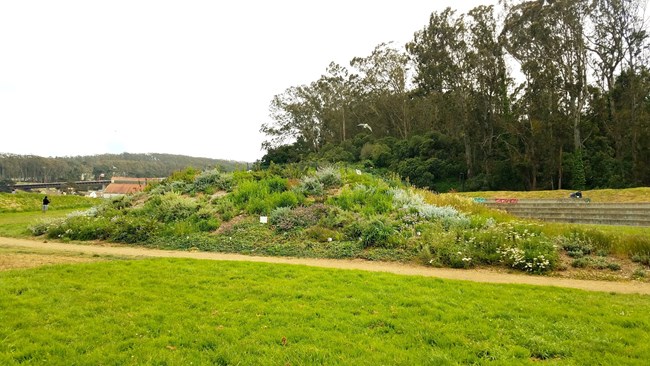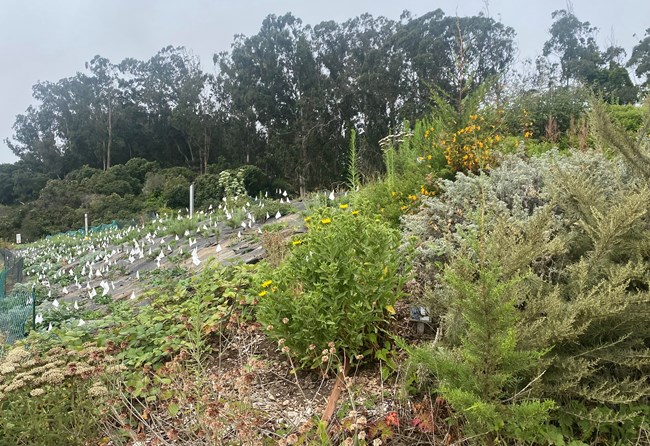Last updated: January 12, 2024
Article
Native Plants Save Water at Crissy Field

Photo from National Park Service
How can a national park in an urban area be both water wise and welcoming in a changing climate? Golden Gate National Recreation Area is in California, a state that is prone to long periods of drought, and as such is defined by the presence or absence of water. With global climate change, the weather will become more unpredictable.
“Weather whiplash,” or swings between more intense periods of drought, heat, and storms means that the amount of water available for ecosystems and people will become more unpredictable, and we risk using more water than can be naturally replenished.
In order to adapt, we must learn to be water-wise and rethink our water systems, and where and how we use water. Here at Golden Gate, our largest use of water goes to landscape irrigation. Now, we are looking at new and unique ways of conserving some of that water.
Crissy Field is a former military airfield and was rehabilitated in 2000. As part of the design, vegetated berms were installed to break up the space, create a sense of entry, and reduce the amount of wind in certain areas. Next to the Warming Hut and East Beach, grounds crew and volunteers are planting native plants to replace the turf and reduce the park’s water usage. These plants, such as yarrow, coyote brush, sticky monkey flower, lupine, and more are all grown at the Presidio Native Plant Nursery run by the Golden Gate National Parks Conservancy.
Almost all the native plants established at East Beach have been planted by volunteers in group programs, according to Jeff Kelly, Crissy Field Maintenance Worker.
Allowing volunteers to participate in projects like these both help the grounds crew focus on other projects as well as help create a sense of community and land stewardship for those that participate.
The planting takes on a natural pattern, Maintenance Worker Mark Nichols says. “We just kind of go at it. We plant smaller plants at the top and vice versa to avoid overshading, and the plants naturally align themselves once established.”
“While having open space for dogs and people to roam around the park will always be provided in great quantity, native plants can break up this space and make it a more diverse and visually stunning environment.”
Nichols shares that the crew has been working to replace all the equipment used at Crissy Field with electric tools. “But this still does not offset the environmental cost of fertilizer and pumped water usage required to keep the [lawns] looking green,” he says. “Native plants do not need this expensive care!”

Photo: National Park Service
The rain and fog we see in the Bay Area provide enough water for these plants, but Nichols explains that the crews will water the young plants until they are fully established. Crissy Field crew can still conserve water however, because the plants only need to be watered very infrequently as opposed to watering a lawn every day.
Additionally, not only are these plants helpful for water conservation, but they are also good for carbon sequestration. Different Lupines, for example, establish long or clustered roots, making them ideal for capturing and storing atmospheric carbon or converting atmospheric nitrogen into other compounds the plant can use.
In areas such as East Beach where there is a lot of wind and parallel traffic, the plants protect the dunes by providing a natural wind block as well as “keeping the berms in place by establishing roots”, says Kelly.
Native plants are also helpful for the small critters and vital pollinators that visit and create their homes in these plants. They provide protection and shelter, in turn increasing the biodiversity of this landscape.
The planting of these native plants is an ongoing project, with more planted areas being expanded every day or when the opportunity arises. Doing so helps the park lower its water usage while simultaneously providing benefits for the ecosystem and its inhabitants.
< Back to GOGA Sustainability Newsletters
